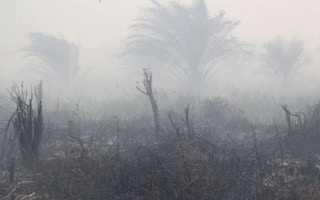A month after Singapore was shrouded in a thick haze produced by Indonesian fires in June 2013, scientist David Gaveau went to the source of the smoke in Riau province to survey the charred aftermath.
News reports attributed the haze to slash-and-burn forest clearance to make way for oil palm plantations. But what Gaveau, a scientist with the Indonesia-based Center for International Forestry Research (CIFOR), discovered during his five days examining the still-smouldering ground on Sumatra island was different.
His team already knew from satellite images that over 80 per cent of the burned 163,336 hectares was “non-forest” land - ranging from scrub and exposed soil to oil palm plantations with trees more than five years old - but they wanted to know what it really looked like.
So Gaveau and his colleague, Mohammad Agus Salim, met up with two drone technicians and snapped aerial images from seven burn sites around Riau. According to a paper published on Tuesday in Scientific Reports, they concluded that 57 percent of the burned “non-forest” land was made up of what they call “forest cemeteries”.
According to Gaveau, these areas had already been stripped of forest, but not yet converted for cultivation: “decapitated stumps, branches lying around, a lot of wood debris - you see the dead trees scattered about”.
“
During a hot day, at noon, the dry peat soil becomes extremely hot, and all it takes are a few consecutive days of little rain for peat to burn even in a wetter-than-average year
David Gaveau, scientist from CIFOR
The fires behind the haze were short-lived and confined to recently deforested peatlands in Riau, reflecting ongoing conversion to oil palm plantations, the researchers wrote in their paper.
In their pristine state, Indonesian peatland swamps are covered in lush tropical forests and are resistant to fire because the ground is wet year-round and the canopy keeps it cool, Gaveau said.
But when the trees are removed and the ground is drained for farming, this land rich in peat – decayed organic matter used as fuel in places like Ireland and Finland – becomes highly flammable.
“During a hot day, at noon, the dry peat soil becomes extremely hot, and all it takes are a few consecutive days of little rain for peat to burn” even in a wetter-than-average year, Gaveau told Thomson Reuters Foundation by telephone from Bali. That is what the scientists observed in June 2013, and also in February-March 2014.
Migrant influx
Until now, transboundary haze events in Southeast Asia occurred during drought years with low rainfall, Gaveau said, pointing to the El Nino years of 1982, 1997 and 2006.
But migrants pouring into the region and using fire to clear land for cultivation have added another dangerous variable, he said.
Just over half the total burned area in Riau in 2013 - nearly 85,000 hectares - was on land allocated to companies for plantation development, but of that area, some 50,000 hectares was also occupied by locals or migrants.
The combination of large numbers of people searching for land and extremely fire-prone peat covered in wood debris “creates this mess”, Gaveau said.
Flameless but dangerous
Peat fires do not have the raging flames seen in wildfires in Southern California and Australia.
“It’s almost like they are flameless fires. It’s not like you have to run away, or the flame will kill you. People still go about their business,” Gaveau said.
However, smouldering peat releases much greater amounts of greenhouse gases per unit of fuel consumed than flaming combustion, he noted.
The CIFOR scientists found that the haze that has angered Singaporeans is due to these smoky fires on land that has remained idle for several years rather than slash-and-burn forest clearance, as commonly thought.
Pristine forests are deemed safe from fires, as are established plantations, because companies and landowners want to protect their assets. It is areas at the in-between stage that are particularly vulnerable.
Gaveau said the transition from forest to farmland in Riau is more complex than scientists had thought, and takes longer than the three years or so they had expected – for reasons they still haven’t worked out.
“What that means is that the same area can burn several times over the course of several years before it gets converted to agriculture. It keeps getting burned and burned and burned.”
This is bad news for Southeast Asia - and in particular Singapore, which has been so hard hit by the haze that earlier this month its parliament passed a bill proposing fines of up to S$2 million ($1.6 million) for companies found guilty of causing it, whether or not they operate on the island.
The smog caused by fires often leads to the closure of airports, and sometimes schools and offices too. It can trigger respiratory diseases, as well as eye and throat infections.
“It is not just city dwellers who are affected, but also, and most importantly, local people who live around these fires,” Gaveau said.










